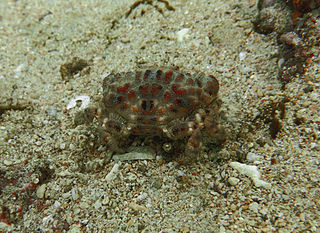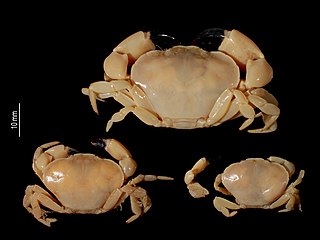Description
The most distinctive feature of G. melvillensis is its oval-shaped carapace and shallow sub-hepatic cavities. Its carapace is broader than it is long, [6] with a ratio of roughly 1:1.2, and it lacks distinction between different regions. The sub-hepatic cavities (or cavities beneath the liver) are not unique to this genus, though they are distinctively shallow and are divided by a prominent crest, with crests along their sides as well. [2]
This crest is thought to work in conjunction with another unique feature, which is its modified claw. This claw has a modified upper arm portion, or merus, being significantly reduced. This reduced appendage is closely aligned with its first and longest leg, with the two being coapted. [2] The purpose of this modification is currently unknown.
Their size ranges from 2.0 to 200 mm, [7] with juveniles tending to have a smaller carapace width to length ratio. This species also has a distinctive gastrointestinal tract, with its dorsal lobe uniquely terminating in a hook shape; this is dissimilar to other Euxanthids, but is reminiscent of other crabs in its family, Xanthidae. It also lacks an external tooth. [2]
It is distinctive from other Euxanthines due to its unusually shaped carapace. Despite this, it is visually similar to other members of the subfamily Euxanthidae, such as Hypocolpus, Carpoporus, and Hepatoporus, with a notable resemblance to Hypocolpus due to the presence of subhepatic cavities. The two are distinguishable by the ratio of the carapace width and length, with it being 1:1.3+ in Hypocolpus and roughly 1:1.2 in G. melvillensis, as well as by this species’s distinctive gastrointestinal tract. [2]
There is notable sexual dimorphism, with females having a less broad carapace, smaller claws, and a distinctive vulva. [2]
Its coloration is undocumented, but it is assumed to be colorful like other xanthids. [8]
G. melvillensis has an anterolateral margin that does not meet the orbital margin but continues to meet antero-external region of the buccal frame. It also has a distinct subhepatic cavities present, with the chelipeds and walking legs that can be neatly fastened together against the carpus, which are ovoid and smooth. [2]
As there is limited research on this species the morphology can be described having the morphology being the most similar to species of hypocolpus. Which can be found in reef prairies of Thalassodendron [4]
They are especially similar in the structure of the basal antennal article, the anterior portion of the sternum, the form of the male abdomen, the cristate anterolateral margin of the carapace, and the way the fingers, palm, and carpus of the chelae follow the curve of the body surface against which they are fastened together [2]
Life History
G. melvillensis are commonly found with the benthic and tropical zones of the ocean. They are members of order Decapoda and are mostly gonochoric.
Habitat
This benthic species [9] has been documented in four locations within the Philippines thus far, including Balabac Island, Sibutu Island, Putic Island, and southern Luzon. [2] This area is known for being particularly dense in marine fauna, with many other species belonging to the infraorder Brachyura residing there. [10] Adult Xanthids are generally found in shallow water, and as such, the known G. melvillensis specimens were collected between depths of 2 to 73 meters. The areas in which they have been found contain coral reefs with large seaweed expanses, residing specifically within coral or on reef flats. This species is postulated to live in subtidal and intertidal zones. [2]
Mating
The reproductive behaviors of this species are not well documented, but based upon members of its order, Decapoda, they have separate male and female individuals that engage in courting behaviors. Copulation is only possible soon after the female molts, [11] at which point the crabs mate via indirect sperm transfer. [9]
Movement
The movement of these creatures is based on the walking legs that they possess. These walking legs densely setose at margins, less so on dorsal and ventral surfaces. They are relatively short, with their first walking legs being the longest.
Larval Stages
Although G. melvillensis has only be found in the Philippines, its larval stages can be compared to that of the family Xanthidae that it is a part of. The crab goes through 5 stages, four zoeal stages and a megalopa stage to end their larval life to enter into the adult stage. [12] During this larval period, they are notably pelagic.
Diet
The diet of G. melvillensis is somewhat unknown but from information taken from the family Xanthidae it can be suggested. Crustaceans are described as opportunistic omnivores as they utilise different types of food. However, most crustaceans are mainly omnivores with a tendency for herbivory in food habitats. For the P. vespertilio, a crustacean in the family Xanthidae similar to G. melvillensis, the most important food source was algae which was obtained by scrubbing the encrusted coralline substratum, with red algae (Rhodophyta) being the most common species to be consumed. The P. verspertilio also feeds on brittle stars, gastropods and bivalves, which displays the range of food sources that the family Xanthidae can consume. [13] It is possible that, like other Xanthids, it contains toxins as a result of its diet, and is thus poisonous. [14]

















